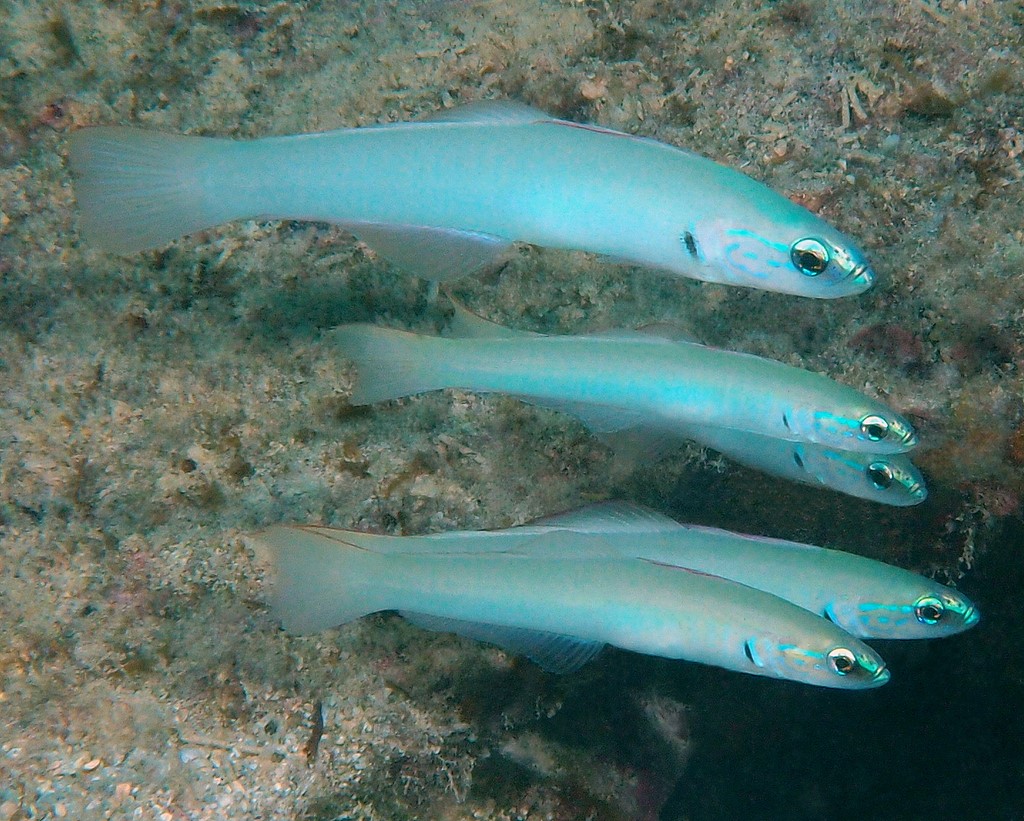PTERELEOTRIS MICROLEPIS - (BLEEKER, 1856)
Actinopterygii (Gigaclass) > Actinopteri (Class) > Teleostei (Subclass) > Gobiiformes (Order) > Gobioidei (Suborder) > Gobiidae (Family) > Ptereleotrinae (Subfamily) > Ptereleotris (Genus)
Goujon bleu, Poisson-fléchette nacré, Greeneye dartgoby, Pale dartfish, Green-eyed goby, Pearly dartfish, Green-eye dart-goby, Long-finned gudgeon, Smallscale hovergoby, blue Gudgeon, Perlen-torpedogrundel, Itoman-kuroyurihaze, イトマンクロユリハゼ, 細鱗鰕虎, 細鱗鰭塘鱧,
Synonymes
Eleotris elongata (Alleyne & Macleay, 1877)
Eleotris microlepis (Bleeker, 1856)
Gracileotris bockensis (Herre, 1953)
Ptereleotris andamensis (Herre, 1939)
Ptereleotris letholepis (Clark, 1938)
Ptereleotris microlepis itomanensis (Aoyagi, 1949)
Ptereleotris playfairi (Whitley, 1933)
Pteroeleotris microlepis (Bleeker, 1856)
-------------------------
Description
Dorsal spines (total): 7; Dorsal soft rays (total): 25-29; Anal spine: 1; Anal soft rays: 24-27; Vertebrae: 26-27; Pectoral fin rays: 21-24; Body Depth: 5.5-7.0 in SL. Chin with a median, fleshy protuberance narrowing to a thin fold. Scales embedded, close-set, non imbricate (except on posterior part). First dorsal fin lower than second; Second dorsal and anal fins elevated anteriorly; Caudal fin slightly emarginate, the corners not rounded. Max. length: 13.0 cm TL. Depth range: 1 - 50 m, usually: 1 - 10 m.
Color
Pale to bluish-grey; Pectoral fin base with a narrow, pale blue-edged, black band; Postorbital head with irregular, pale to iridescent blue bands and spots.
Etymology
Ptereleotris: from Greek, pteron = wing, fin + the Greek name of a fish, eleōtris, found in the swampy waters of the Nile (Egypt); From the Greek, eleios = who lives in the marshes. The name Eleotris appears for the first time in Déipnosophistes, a compilation of anecdotes and quotations from ancient authors, written by a scholar and grammarian Greek, Athenaeus of Naucratis (about 170-223 AD). In 1763, the Dutch naturalist and collector Laurentius Theodorus Gronovius (1730-1777) used this name to designate a new genus of fish. The authorship of the genre escapes him because his work was rejected by the scientific community of the time. The genre should have returned to the doctor, entomologist and naturalist of Italian culture, Giovanni Antonio Scopoli (1723-1788) but the late recognition of his work made him lose the authorship of the name. Today the genus, Eleotris, is attributed to Bloch & Schneider, 1801.
microlepis: from Latin, micro- = small + from Latin, lepis = scale. Referring to very small and embedded scales.
Original description: Eleotris microlepis Bleeker, 1856 - Type locality: Banda Islands, Molucca Islands, Indonesia.
Distribution
Red Sea, Indo-West Pacific: East Africa, South Africa, Persian Gulf and Madagascar east to Hawaiian Islands, Line Islands and Tuamotu Archipelago, north to southern Japan, south to Western Australia, New South Wales (Australia), New Caledonia and Tonga.
Biology
Inhabits lagoon and seaward reefs, over rubble and sand bottoms. Occur in pairs occupying the same burrow, but at times more than two individuals will retreat to the same refuge (particularly true for juveniles). Monogamous mating is observed as both obligate and social. Feeds on zooplanktons.
Similar species
Ptereleotris heteroptera (Bleeker, 1855) - Reported from New Caledonia - Link to the species (here).
Synonymes
Eleotris elongata (Alleyne & Macleay, 1877)
Eleotris microlepis (Bleeker, 1856)
Gracileotris bockensis (Herre, 1953)
Ptereleotris andamensis (Herre, 1939)
Ptereleotris letholepis (Clark, 1938)
Ptereleotris microlepis itomanensis (Aoyagi, 1949)
Ptereleotris playfairi (Whitley, 1933)
Pteroeleotris microlepis (Bleeker, 1856)
-------------------------
Description
Dorsal spines (total): 7; Dorsal soft rays (total): 25-29; Anal spine: 1; Anal soft rays: 24-27; Vertebrae: 26-27; Pectoral fin rays: 21-24; Body Depth: 5.5-7.0 in SL. Chin with a median, fleshy protuberance narrowing to a thin fold. Scales embedded, close-set, non imbricate (except on posterior part). First dorsal fin lower than second; Second dorsal and anal fins elevated anteriorly; Caudal fin slightly emarginate, the corners not rounded. Max. length: 13.0 cm TL. Depth range: 1 - 50 m, usually: 1 - 10 m.
Color
Pale to bluish-grey; Pectoral fin base with a narrow, pale blue-edged, black band; Postorbital head with irregular, pale to iridescent blue bands and spots.
Etymology
Ptereleotris: from Greek, pteron = wing, fin + the Greek name of a fish, eleōtris, found in the swampy waters of the Nile (Egypt); From the Greek, eleios = who lives in the marshes. The name Eleotris appears for the first time in Déipnosophistes, a compilation of anecdotes and quotations from ancient authors, written by a scholar and grammarian Greek, Athenaeus of Naucratis (about 170-223 AD). In 1763, the Dutch naturalist and collector Laurentius Theodorus Gronovius (1730-1777) used this name to designate a new genus of fish. The authorship of the genre escapes him because his work was rejected by the scientific community of the time. The genre should have returned to the doctor, entomologist and naturalist of Italian culture, Giovanni Antonio Scopoli (1723-1788) but the late recognition of his work made him lose the authorship of the name. Today the genus, Eleotris, is attributed to Bloch & Schneider, 1801.
microlepis: from Latin, micro- = small + from Latin, lepis = scale. Referring to very small and embedded scales.
Original description: Eleotris microlepis Bleeker, 1856 - Type locality: Banda Islands, Molucca Islands, Indonesia.
Distribution
Red Sea, Indo-West Pacific: East Africa, South Africa, Persian Gulf and Madagascar east to Hawaiian Islands, Line Islands and Tuamotu Archipelago, north to southern Japan, south to Western Australia, New South Wales (Australia), New Caledonia and Tonga.
Biology
Inhabits lagoon and seaward reefs, over rubble and sand bottoms. Occur in pairs occupying the same burrow, but at times more than two individuals will retreat to the same refuge (particularly true for juveniles). Monogamous mating is observed as both obligate and social. Feeds on zooplanktons.
Similar species
Ptereleotris heteroptera (Bleeker, 1855) - Reported from New Caledonia - Link to the species (here).
